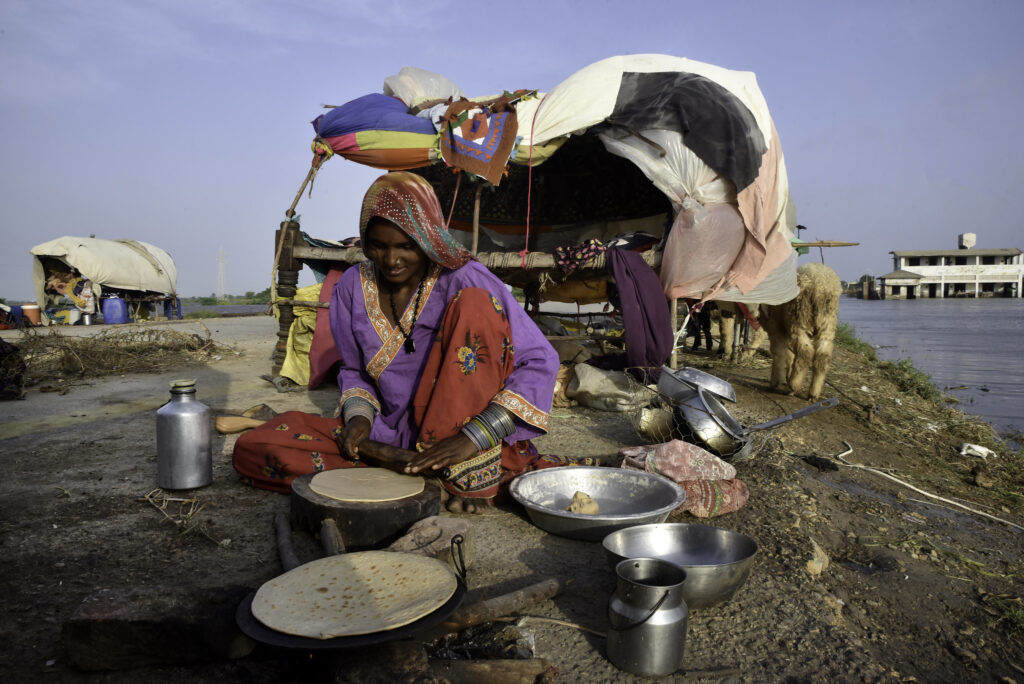
Editors’ note: In this archival piece, contributor Erum A. Haider looks at the role of governance in Pakistan’s environmental crisis. This analysis was previously published in the Washington Post in September 2022, as millions of people in Pakistan were displaced by widespread flooding.
Pakistan’s 2022 floods are a result of a climate crisis a century in the making. Climate experts predict Pakistan will see devastating floods more frequently, interspersed with periods of extreme heat and drought.
While some studies suggest that this year’s flooding is unique, experts say the warning signs for increasingly intense monsoons have been repeatedly ignored. And while climate change is the primary villain in this saga, the intense flooding is also the result of challenges endemic to Pakistan’s political institutions.
It is no coincidence that the areas most affected by the floods today are also the poorest and least developed in the country. A 2015 map of the districts with the lowest educational attainment in the country virtually overlaps with the United Nations’ Situation Report from early September. Weak governance and underinvestment in citizens seem to predict “natural” disasters, too.
Flooding is only one part of Pakistan’s broader water and environmental crisis
In addition to frequent flooding, my research suggests Pakistan also faces a very different type of water crisis. In a study conducted in January in urban Karachi, my co-author and I found that low-income households were spending up to 12 percent of their monthly income on a few jerrycans of non-potable, brackish water.
Nearly 30 percent of the people interviewed in that study reported living on less than 30 liters of water a day — well below the U.N. threshold of 50 to 100 liters of water per person. The mismanagement of water and drainage systems across the country points to deep inequalities in access to basic needs and severe underinvestment by the national and local governments.
These types of inequalities show up in other vital services, as well. My work on electricity privatization in Karachi, Pakistan’s largest city, suggests that large urban neighborhoods are collectively punished with scheduled blackouts when individuals fail to pay mounting electricity bills on time. As studies in India, South Africa and elsewhere note, liberalization of service delivery can sometimes provide elites an unfair advantage in shaping the rules to suit their own needs. And political elites in Pakistan, and elsewhere, are reluctant to give up power.
Absent investments in education, infrastructure and institutions, it’s common to see votes exchanged for basic needs, such as access to water or electricity. Meanwhile, studies point to a failure of the Pakistani government to invest in a community-centered national environmental-protection plan, choosing to focus only on disaster mitigation.
Good governance at the local level offers one path forward
Are there best practices that might inform policy changes? Local communities can have considerable success in maintaining infrastructure projects, such as roads and irrigation channels.
Recent work finds that communities in the semiautonomous region of Gilgit-Baltistan in northern Pakistan benefit from very high levels of education, strong community organizations and deep commitments to ecological sustainability.
In 1997, a community in this region created a conservation trust, run by villagers, in the face of government attempts to transform the region into a tourist destination. Today, the region faces an existential threat from intense timber logging and encroachment by hotels and guesthouses along water channels — much of which is sanctioned by the government. Nevertheless, the conservation trust has sustained its work amid these threats, and this region continues to be one of the most climate resilient, with its communities autonomously working toward adaptation.
What role will international assistance play?
Political institutions in Pakistan are the result of complex domestic and local factors, but they also reflect international influences. Pakistan has long occupied a central role in the foreign policy of the United States and Europe, for strategic reasons. In the aftermath of this year’s floods, many within and outside Pakistan have emphasized the need for accountability from the national government. Others focused on demands for international aid, loan forgiveness and even climate reparations.
Pakistan continues to depend on loans and technical assistance from global lenders to stabilize its economy. Last year, a U.N. Environment Program report stated that the inability of countries such as Pakistan to adapt to climate change was at least partially due to a global failure in financing climate resilience.
In Pakistan and elsewhere, the window for climate adaptation is shrinking rapidly, according to that U.N. report. Any hope that Pakistan has at preparing for the future depends on strong and urgent commitments toward climate resilience from international and national policymakers.
Erum Haider (@erumrum) is an assistant professor of political science and environmental studies at the College of Wooster in Ohio.



